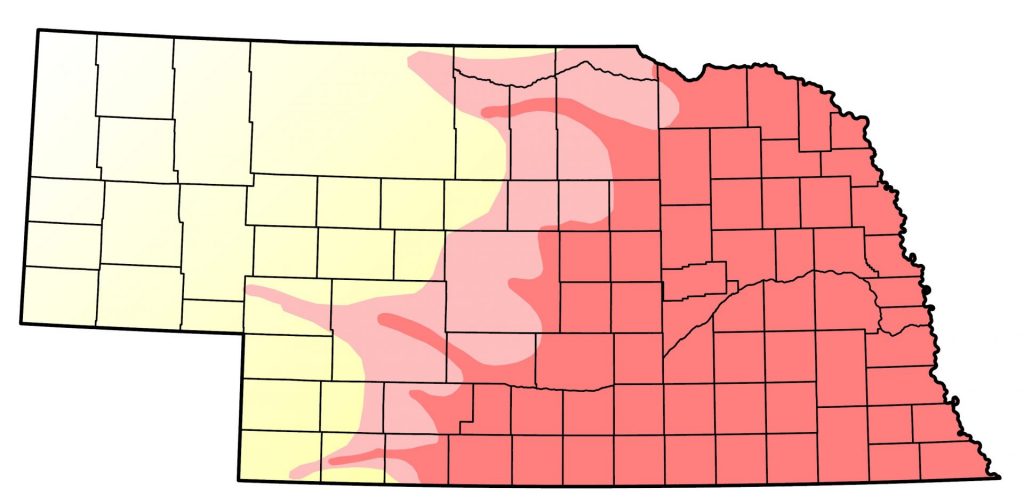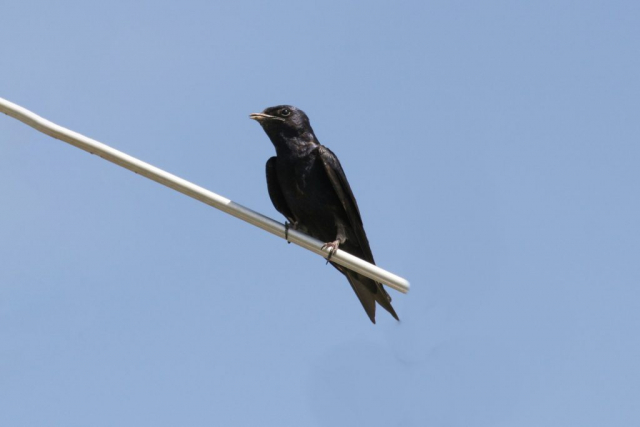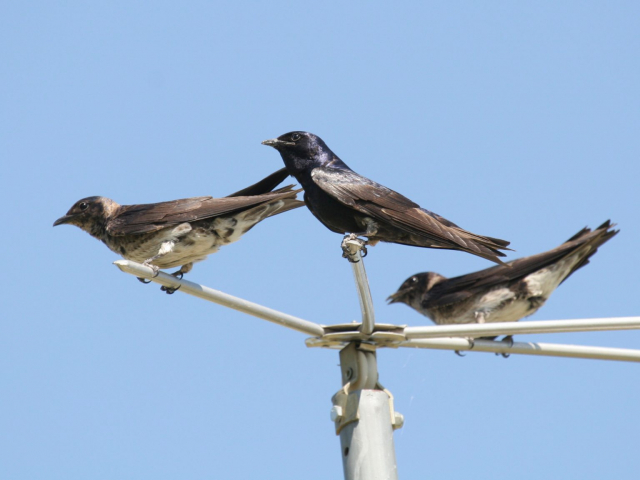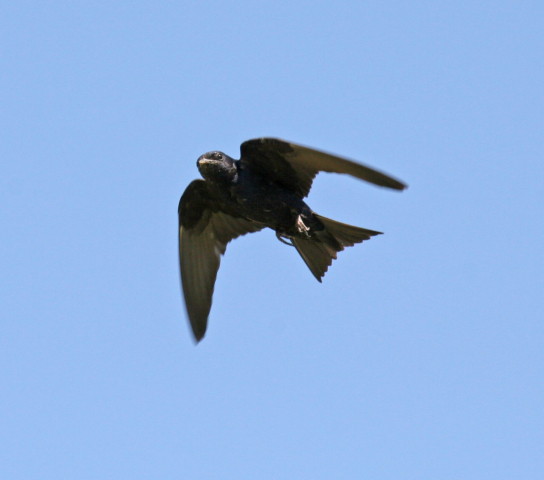Progne subis
Status: Common regular spring and fall migrant east, uncommon central, rare casual west. Common regular breeder east, locally common east central, rare west central.
Documentation: Specimen: UNSM ZM10234, 30 May 1895 Lancaster Co.
Taxonomy: Three subspecies are recognized (AviList 2025): arboricola of coastal British Columbia to southern California and New Mexico, hesperia of southern Arizona, and subis from east-central British Columbia to south Texas and east to Newfoundland and Florida.
Nebraska birds are presumed subis.
Spring: Mar 22, 23, 24 <<<>>> summer
Earlier dates are 10 Mar 2011 Kearney Co, 17 Mar 2024 Buffalo Co, 18 Mar 2024 Lancaster Co, and 18 Mar 2025 Lancaster Co.
This species arrives early in spring, with male “scouts” arriving first, sometimes to perish in inclement weather. Females arrive later; one was in Otoe Co by 31 Mar 2012. Arrival of larger numbers occurs in late Mar, and numbers peak in early May.
Away from Lewellen in Garden Co, an occasional breeding location, there are few Panhandle reports: 21 Apr 1953 Dawes Co, 2 May 2020 Scotts Bluff Co, 7 May 1996 Garden Co, 10 May 1949 Dawes Co, six on 1 May 1996 Sheridan Co (Grzybowski 1996), 20 May 1961 Scotts Bluff Co, 23 May 1959 Scotts Bluff Co, two on 27 May 2018 Gordon, Sheridan Co, and 28 May 2010, 31 May 2009, 3 Jun 2023 Crescent Lake NWR, Garden Co, and 5 Jun 2024 Chadron, Dawes Co (see Summer for later dates).
A study by Jorgensen and Brenner (2024) found that spring arrival dates had advanced by three days from 1938 to 2024.
- High counts: 300 along 833rd Road, Madison Co 19 and 27 Apr 2025, “hundreds” at Wehrspann Lake, Sarpy Co 5 May 2013, 100 in Lincoln, Lancaster Co 5 May 2023, and 80 at Wagon Train RA, Lancaster Co 9 May 2021.
Summer: Around 1900, Purple Martin occurred primarily in the south and east, in the Elkhorn River drainage northwest to West Point, Norfolk, and Neligh, the Loup River drainage northwest to Broken Bow and Callaway, and in the Platte River Valley west to North Platte (Bruner et al 1904). Swenk (1906) cited his observations in summer 1905 at Imperial, Chase Co 22 Jun and Stratton, Hitchcock Co 28 Jun, presumably spring stragglers. Since then, there has been gradual westward range expansion in these river drainages and elsewhere, notably the Niobrara and Republican River Valleys. Probably most of this expansion is due to installation of nesting boxes (Tout 1947, Brown and Tarof 2020).
Along the upper Elkhorn River Valley, where breeding was cited by Bruner et al (1904) in Neligh, it is likely that westward movement involved a jump to tributaries of the Niobrara River at Ainsworth, Brown Co. Breeding has occurred at Ainsworth since at least 1964, when Short (1965) found them common over the town. However, Brogie and Mossman (1983) did not find this species at the Niobrara Valley Preserve in 1982, and the only records between the west edge of Knox Co and Valentine in the Niobrara River Valley are of two probable “scout” reports from Springview, Keya Paha Co 16 May 2017 and 13 Jun 2009, one at Norden Road, Keya Paha Co 1 Jun 2019, one in Boyd Co 24 Apr 2018, and one at Niobrara Valley Preserve in Brown Co 12 May 1984.
These reports suggest that westward expansion has taken place via the Elkhorn River drainage to Niobrara River tributaries southwest of Valentine and to Valentine itself, where colonies have established in elaborate martin houses constructed by local resident Lester Dooley (James Ducey, personal communication). There has been a breeding colony in northeast Valentine at the Dooley residence in the 500 block of North Ray hosting as many as 40 pairs since at least 1982 (James Ducey, personal communication; Mark Brogie, personal communication). A second location as of 2021 is along West Candice (James Ducey, personal communication), where up to seven were present in summer s of 2022 and 2023. A colony at the Wacky West RV Park at the east edge of Valentine, active in 2015 (Keith Dyche, personal communication), is no longer present as of 2021 (James Ducey, personal communication). There are numerous additional reports from unspecified locations around Valentine. In 2023 there were reports of up to six from eight sites in and near Fort Niobrara NWR, Cherry Co. Perhaps the largest colony in the Elkhorn River Valley is at Lake Enola, Madison Co, with 180 pairs in 2023.
Since around 2015 reports west of Valentine in Cherry Co are increasing. 1-3 were at Valentine NWR 9-18 Apr 2015, as well as 2022 and 2023. In 2023 two were at NNF McKelvie 26 May, and one at Merritt Reservoir 23 May. Five were at Cody, Cherry Co 14 Jun 2024, and five at Crookston 11 Jun 2025.
In the western Loup River drainage, there was a series of reports from Logan Co as early as 1934 (Glandon and Glandon 1934), but only two since then, 6 May 2007 and 15 May-13 Jun 2024, both at Stapleton. One was farther west in McPherson Co, at Ringgold, 13 Jun 2024. Two were near Ashby, Grant Co 22 May, 2023 apparently a first county record, as was one at Mullen, Hooker Co 18 Jun 2025. There are three records for Thomas Co: six near Halsey 12 May 2023, two near Thedford 13 May 2022, and five at Thedford 9 Jun 2023. There was an established colony as of 2017 in the Broken Bow area of Custer Co where the species has been present since the time of Bruner et al (1904); there were 2-3 there 18-19 May 2024. There may have been a colony at Arnold, Custer Co at one time (Mark Brogie, personal communication) but there have been no recent reports from there. There are reports from the Calamus and Sherman Reservoirs, Loup and Sherman Cos respectively and at Burwell, Garfield Co; up to 10 were at Burwell 30 May-4 Jul 2024. One was in northeastern Lincoln Co 14 Apr 2012.
Purple Martins have long been present in the Platte River Valley, as far west as North Platte (Bruner et al 1904). Tout (1947) indicated that erection of martin houses had resulted in some nesting in North Platte, probably in the 1930s, although no dates were given. Of interest was Tout’s observation of Purple Martins nesting on a downtown North Platte building “for several summers around 1910” before House Sparrows had become common. Small populations breed regularly in the North Platte Valley west as far as the Lake McConaughy area, Keith Co; around 1977-79 Lewellen, in Garden Co, was considered the “westernmost regular nesting site in Nebraska” (Rosche and Johnsgard 1984). The most recent report from the Lewellen area is of up to six at Clear Creek WMA 31 May-2 Jul 2024. Westernmost current (2023) breeding is at Ogallala and Lake McConaughy, Keith Co, where nesting birds have been present at least since 2004. There are no records for Jun-Jul west of Ogallala in the South Platte River Valley in Nebraska; two at Prewitt Reservoir, Washington Co, Colorado 10 Jul 2004 were probably migrants (eBird.org, accessed Nov 2023).
The only recent summer reports from the Panhandle away from Garden Co (above) are 10 Jun 1990 Cheyenne Co, 16 Jun 2022 Alliance, Box Butte Co, 2 Jul 2002 Scottsbluff, Scotts Bluff Co, and 29 Jul 2010 Bridgeport SRA, Morrill Co.
There are only scattered reports throughout the Republican River Valley, although regular breeding has probably occurred there since the 1960s. Mollhoff (2001) showed a confirmed breeding record along the Republican River in southeast Dundy Co, presumably at Benkelman, where summering birds have been present at least since 1989; it was “numerous” at the Benkelman site 13 Jun 2014, up to 60 were there 11 Jun 2017, 100 on 23 May 2020, and 20 on 17 May 2023. Two were at Rock Creek SRA, Dundy Co 21 Jun 2014. It is common in Culbertson, Hitchcock Co where it has nested since 1965. In the tributary Frenchman Creek Valley, there have been sporadic reports for Chase Co since 1982, including 25 at Enders Reservoir 1 Jul 2011. The only reports from Perkins Co are 29 Jul 1973, two at Grant 18 Jun 2011, two there 6 Jul 2017, and one on 13 Jun 2018. Small colonies may have established from time to time in Imperial and Grant (Mark Brogie, personal communication).
Even though Purple Martins have increased their range since the early 1900s, BBS trend analysis for 1966-2019 (Sauer et al 2020) indicates the species has gradually declined statewide at an annual rate of -0.61% (95% C.I.; -2.68, 1.6). Mollhoff (2016) noted a small decrease in the number of reports between the first and second BBA projects.
- Breeding Phenology:
- At martin house: 23 Mar
- Nest building: 19 Jun
- Eggs: 24 Apr- 30 Jun (Mollhoff 2022)
- Nestlings: 6 Jul
Fledglings: 1 Jun-4 Aug
Colony abandoned post-breeding: 29 Jul
Fall: summer <<<>>> Sep 26, 26, 27
Later dates are 29 Sep 2015 Douglas Co and 30 Sep 2021 Lancaster Co.
Departure is early, generally in Aug and early Sep, although flocks form in late Jul after colonies are abandoned following breeding in late Jul-early Aug; 1200-1500 were migrating over Omaha, Douglas Co 30 Jul 2007.
The six Panhandle reports, presumably of migrants, are 29 Jul 2009 (9) Dawes Co, 2 Aug 2012 Ash Hollow SHP, Garden Co, 5-23 Aug 1905 Glen, Sioux Co (Swenk 1906, Mollhoff 2001), 21 Aug 1999 Kimball Co, three on 5 Sep 2017 Morrill Co, and, rather late, a juvenile 13 Sep 2013 Lake Minatare, Scotts Bluff Co. One at Grant, Perkins Co 16 Jul 2023 was probably a migrant.
Purple Martins are known for forming very large post-breeding roosting aggregations. A major roost in downtown Omaha in the area of 44th and Farnam Street near the University of Nebraska Medical Center was first reported in 2008 when there was a peak count of 35,000 enjoyed by good crowds of the public resulting from publicity by local newspapers and TV stations, as well as expert birders Jim Ducey and Justin Rink and others. Subsequent peak counts (Ducey, Rink) were 65,000 during 23-28 Aug 2010, 65,000 on 1 Sep 2011, 60,000 on 27 and 30 Aug 2012, 70,000 on 1 Sep 2013, and 45,000-50,000 in both 2014 and 2015, but in 2016 the peak count was only 5000 as the roost shifted a short distance north (Jerry Toll; Silcock 2016). Birds first appear at the roost in late Jun and most have departed by mid-Sep, soon after reaching peak numbers. The 44th and Farnam roost was abandoned in 2017, possibly due to major hospital construction nearby (Justin Rink; Silcock 2017), but a new roost formed in Omaha in 2018 in the area of 22nd and St. Mary’s Avenue (Donald and Janis Paseka, Jerry Toll; Silcock 2018). Peak count at the latter site was 10,000-15,000 on 31 Aug; the birds were seen to depart “en masse” to the southeast early on 4 Sep. In 2022 however, the roost near 42nd and Farnam appeared to be reestablishing; 10,000-12,000 martins were there 8-14 Aug. In 2023 a large roost formed at Pacific and 11th in Omaha; at least 20,000 were estimated 24 Aug (Jerry Toll, personal communication). A large aggregation of at least 2500 returned to Haworth Park, Sarpy Co on two consecutive nights 29-30 Aug 2018. Lincoln, Lancaster Co hosted a roost of 10,000 birds 30 Aug-3 Sep 2019.
- High (non-roost) counts: 12,000-15,000 over Omaha 20 Aug 2007, 4000-5000 in Douglas Co 21 Aug 2011, 3700 at Lincoln Saline Wetlands NP, Lancaster Co 30 Aug 2021, 3160 there 12 Aug 2023, and 1700 there 2 Aug 2024.
Images
Abbreviations
BBA: Breeding Bird Atlas
BBS: Breeding Bird Survey
NNF: Nebraska National Forest
NP: Nature Park
NWR: National Wildlife Refuge
RA: Recreation Area
SHP: State Historical Park
SRA: State Recreation Area
UNSM: University of Nebraska State Museum
Literature Cited
AviList Core Team, 2025. AviList: The Global Avian Checklist, v2025. https://doi.org/10.2173/avilist.v2025.
Brogie, M.A., and M.J. Mossman. 1983. Spring and summer birds of the Niobrara Valley Preserve, Nebraska: An annotated checklist. NBR 51: 44-51.
Brown, C.R. and S. Tarof. 2020. Purple Martin (Progne subis), version 1.0. In Birds of the World (A. F. Poole, Editor). Cornell Lab of Ornithology, Ithaca, NY, USA. https://doi.org/10.2173/bow.purmar.01.
Bruner, L., R.H. Wolcott, and M.H. Swenk. 1904. A preliminary review of the birds of Nebraska, with synopses. Klopp and Bartlett, Omaha, Nebraska, USA.
Glandon, E.W., and R. Glandon. 1934. Additions to the list of Logan County birds. NBR 2: 61.
Grzybowski, J.A. 1996. Southern Great Plains Region. Field Notes 50: 74-77.
Jorgensen, J.G., and S.J. Brenner. 2024. The changing spring migration patterns of selected bird species in Nebraska 1938-2024. Joint Report of the Nongame Bird Program at the Nebraska Game and Parks Commission and Audubon Great Plains, Lincoln, Nebraska, USA.
Mollhoff, W.J. 2001. The Nebraska Breeding Bird Atlas 1984-1989. Nebraska Ornithologists’ Union Occasional Papers No. 7. Nebraska Game and Parks Commission, Lincoln, Nebraska, USA.
Mollhoff, W.J. 2016. The Second Nebraska Breeding Bird Atlas. Bull. Univ. Nebraska State Museum Vol Pyle, P. 1997. Identification Guide to North American Birds. Part I, Columbidae to Ploceidae. Slate Creek Press, Bolinas, California, USA.
Mollhoff, W.J. 2022. Nest records of Nebraska birds. Nebraska Ornithologists’ Union Occasional Paper Number 9.
Rosche, R.C., and P.A. Johnsgard. 1984. Birds of Lake McConaughy and the North Platte River Valley, Oshkosh to Keystone. NBR 52: 26-35.
Sauer, J.R., W.A. Link, and J.E. Hines. 2020. The North American Breeding Bird Survey, Analysis Results 1966 – 2019: U.S. Geological Survey data release. https://doi.org/10.5066/P96A7675.
Short, L.L., Jr. 1965. Bird records from northern Nebraska during the breeding season. NBR 33: 2-5.
Silcock, W.R. 2016. Fall Field Report, August-November 2016. NBR 84: 154-179.
Silcock, W.R. 2017. Fall Field Report, August-November 2017. NBR 85: 146-178.
Silcock, W.R. 2018. Fall Field Report, August-November 2018. NBR 86: 146-167.
Swenk, M.H. 1906. Some Nebraska bird notes. Auk 23: 108-109.
Tout, W. 1947. Lincoln County birds. Published by the author, North Platte, Nebraska, USA.
Recommended Citation
Silcock, W.R., and J.G. Jorgensen. 2025. Purple Martin (Progne subis). In Birds of Nebraska — Online. www.BirdsofNebraska.org
Birds of Nebraska – Online
Updated 27 Aug 2025. Map updated 18 Jul 2022



